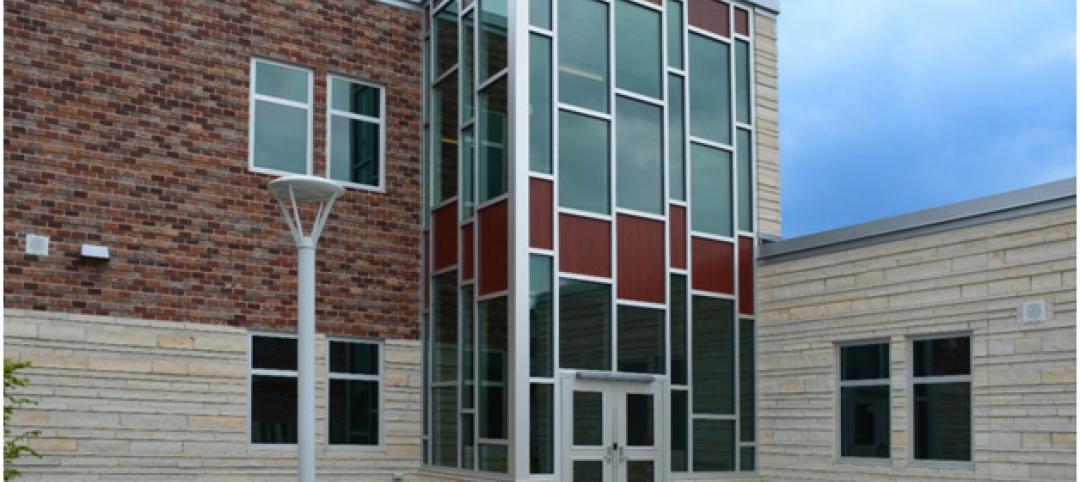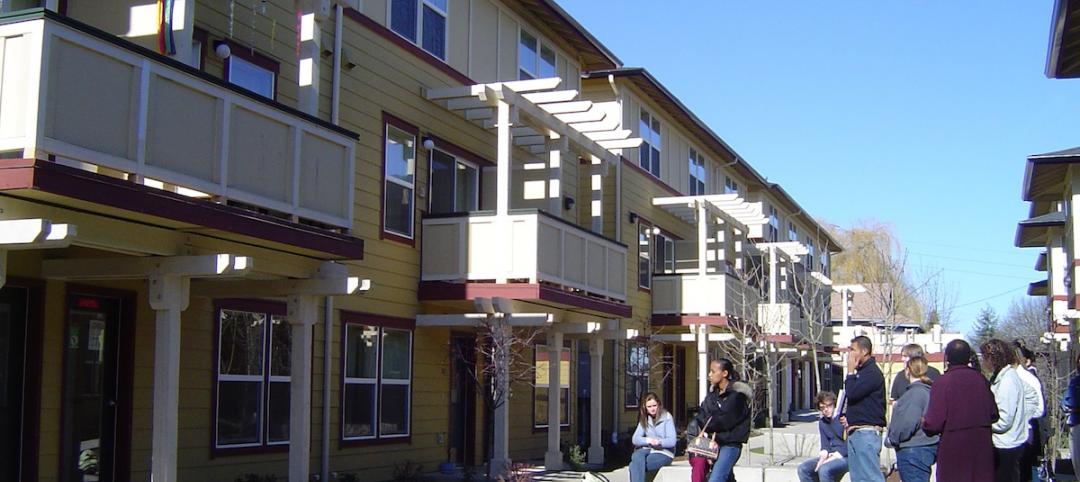 |
| The Whole Foods Market in Napa Valley boasts a 1,200-sf culinary center. |
Sectioning off large open spaces without making everything feel closed off was the challenge faced by two very different projects—one an upscale food market in Napa Valley, the other a corporate office in Southern California. Movable glass wall systems proved to be the solution in both projects.
The new Whole Foods Market in the heart of Napa Valley's wine country was designed to be a grander version of your typical neighborhood Whole Foods. A major enhancement, a 1,200-sf culinary center at the heart of the 50,000-sf store, needed to be closed off from the sales floor when cooking classes or private events were in session.
Closing off any part of the store, however, ran counter to the open-air market concept created by the San Francisco design firm Field Paoli. Their plan called for capturing the casual, indoor/outdoor lifestyle of Northern California by blurring internal/external boundaries. At the same time, they wanted to imbue the culinary center—an interior space—with a sense of connection to the outside.
 |
| A NanaWall system connects the center and the store, and provides privacy when cooking classes and special events are held. |
The architects had already specified a NanaWall door system on the front façade, and they felt that using NanaWall inside the store might offer that same sense of openness. "It's not often you see what's considered a storefront system in the interior of the space," says Christen Soares, an associate at Field Paoli. "But using NanaWall lends itself to the feeling of being open to the outside without actually being open to the exterior," she says.
The opening between the culinary center and the rest of the Whole Foods sales floor is about 20 feet wide. The curved, segmented door system used to section off the space consists of wood-framed glass panels roughly three feet wide, with two swinging panels for ingress and egress. The custom system can be completely opened or partially closed in a variety of configurations; the market typically keeps them wide open unless there's a class or event in progress. Privacy wasn't an issue, says Bill Brigham, principal at Field Paoli. "There are no blinds on the panels, it's all open. The intent was to have it as open as possible." Nor was noise a concern. "There was no worry about STC ratings," he says. "The culinary center opens into the 'Whole Body' department, which is soft goods—lotions and clothing rather than groceries—so it isn't a particularly noisy one."
"The whole point of using NanaWall inside and out was a cross-fertilization between indoor and outdoor, public and private space," says Brigham. "I feel like we've succeeded in enclosing space without making any of it them feel isolated."
 |
| When the Moveo wall systems are open, the BeachBody office in Santa Monica, Calif., has a multifunction, 2,500-sf great room . |
When BeachBody was moving its offices from Beverly Hills to Santa Monica, Calif., the health and fitness company wanted an open-plan space that would be flooded with natural daylight. Designers at Wolcott Architecture|Interiors of Culver City, Calif., were tasked with creating flexible conference spaces that offered privacy without blocking light from filtering into the office.
The architects devised an open great room concept for the office's entry, and located two conference rooms within the space that can be sectioned off with custom Moveo glass wall systems from Modernfold. When open, the space functions as one large, bright 2,500-sf great room for parties, meetings, and other large gatherings. When closed, the glass panel systems section the room into three light-filled spaces: reception and staff lounge, large conference room (550 sf), and medium conference room (325 sf). Seventy-five linear feet of glass panels are used in the great room.
In creating the room separations, the movable panels had to form two corners, and there could be no recessed tracks in the floor that would make it awkward using the space when it's fully opened. The glass panels also had to provide significant sound isolation. "These were huge issues, and it was a challenge finding something that worked," says Mika Yagi, senior designer at Wolcott.
 |
| When closed, the office has two conference rooms and a separate reception area/employee lounge. Note the unobtrusive solid corner panels. |
The corners were particularly difficult to configure. "We obviously didn't want corner posts, which would interrupt the great room concept, and we initially didn't want solid panels, which would block daylight," says Yagi. A structural element was needed, and a compromise was reached: Solid panels were positioned at the inside corners, making them virtually imperceptible and blocking little daylight when the conference rooms are in use.
It was also important to Yagi that the panels operate without channel tracks in the floor; the aluminum-framed panels are hung at the ceiling and manually opened and closed. When open, they stack against the wall rather than being stored in pockets.
To achieve acoustic privacy in the conference rooms, Yagi says she went through four different glass options before finally deciding on the Moveo system. "BeachBody wanted an STC rating of at least 43, which is what you typically get in a conference room with drywall construction," says Yagi. The Moveo system offered an STC rating of 45.
Yagi says the client is pleased with the final set-up. The office has a flexible, open-space plan, access to two private conference rooms, and plenty of daylight no matter how the conference rooms are configured.
Energy use has been cut by 25% compared to conventional office design, which helped earn the 55,000-sf space LEED CI Gold.
Related Stories
Building Enclosure Systems | Apr 12, 2016
Water Vapor Migration 101 [AIA course]
This course will describe how to select vapor retarders to control moisture migration and prevent condensation within the building enclosure. To earn 1.0 AIA CES HSW learning units, study the article carefully and take the exam.
| Jan 28, 2016
AIA CES class: The rainscreen approach to a better building envelope
Building envelope expert Bradley Carmichael of Hoffmann Architects explains how rainscreen wall systems work and evaluates the effectiveness of various rain-control methods, including mass walls, perfect barriers, and masonry veneers. This AIA/CES class is worth 1.0 learning unit.
| Jan 14, 2016
How to succeed with EIFS: exterior insulation and finish systems
This AIA CES Discovery course discusses the six elements of an EIFS wall assembly; common EIFS failures and how to prevent them; and EIFS and sustainability.
Insulation | Oct 19, 2015
The expert’s guide to insulation materials
Even the best-designed envelopes can be undermined by thermal bridging in areas where insulation is deficient. Building envelope experts offers advice.
Building Enclosure Systems | Aug 11, 2015
Deriving value from coordinated building enclosure shop drawings
Building enclosure shop drawings play a critical role in guarding against common performance, cost, and schedule pitfalls associated with the transitions between adjacent enclosure components. Engineers with Simpson Gumpertz & Heger provide tips for success.
Sports and Recreational Facilities | Jul 23, 2015
Japan announces new plan for Olympic Stadium
The country moves on from Zaha Hadid Architects, creators of the original stadium design scrapped last week.
Sponsored | Building Enclosure Systems | Jul 20, 2015
Fire Rated Curtain Wall Performance in Dramatic Weather Conditions
Materials selected for the building envelope had to protect occupants from Wisconsin's weather, as well as ensuring their comfort.
Multifamily Housing | Mar 16, 2015
New Jersey Supreme Court puts control of affordable housing agency in the courts
The court said the state’s affordable housing agency had failed to do its job, and effectively transferred the agency's regulatory authority to lower courts.
Brick and Masonry | Feb 5, 2015
3D-printed 'cool brick' may provide cooling solution for arid locations
Cool Brick is made of porous ceramic bricks set in mortar. The bricks absorb water, which cools the air as it passes through the unit.















